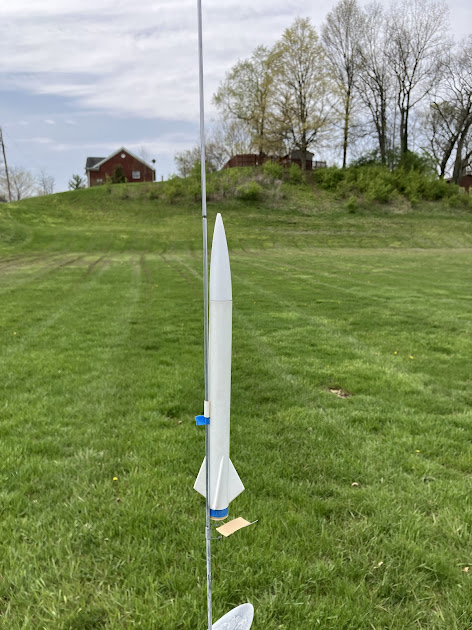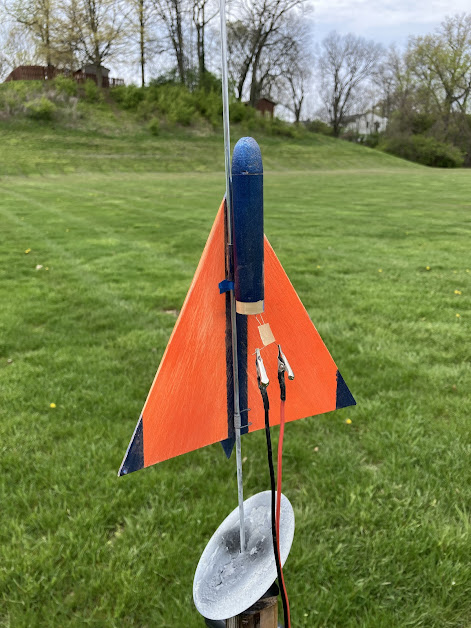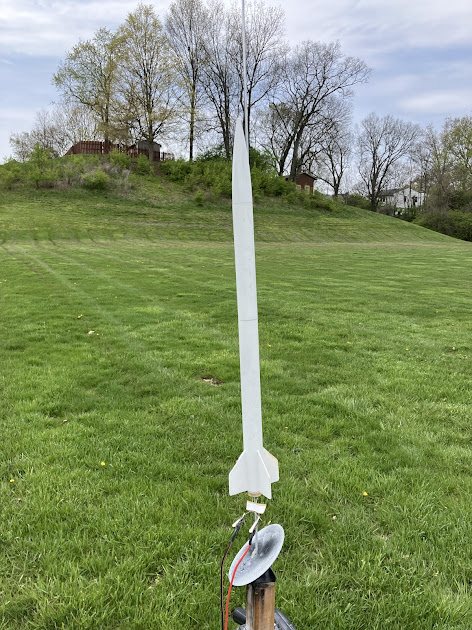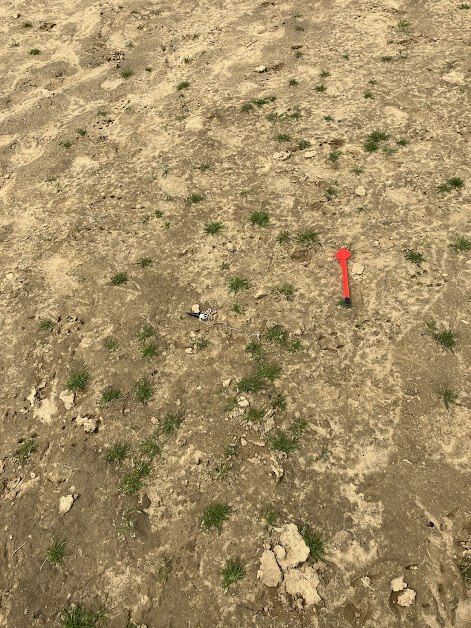We had some fairly serious flooding the previous week, but Sunday the 13 was actually our third straight day without deluge. Saturday was actually the better day of the weekend, at least from a wind standpoint, but it was also the choice day for softball, and I'm not comfortable flying with a game going on. Sunday was breezier, but there were no games scheduled. There was a practice going on when we came home from dinner, but that was done by the time I arrived at the field a little after two. Two girls arrived on scooters toting bats right after I set up, but I could see that the mud and lack of interest would mean they would be gone in less than 30 minutes. I was set up in deep left, while they were at home plate, so with a whole field between us I decided to go ahead with my launch.
I'm working my way through the rockets that haven't seen airtime since before 2020. Today's batch was a mix of those that were with me last month, some new ones, and some recently rediscovered ones. The first flight would be a perfect example of the rediscovered ones. I threw Oscar the Grouch together the night before a competition in 2015. Everything about him was garbage and after his competition flights, he pretty much returned to the trash can. I recently found him while cleaning the shop and almost threw him out before I decided he was worth having around as a wind test bird. That's how he came to be first on the pad today.
The original cone is no longer with us, but I found an Alpha cone in my stash that seemed light enough to fit the bill. Oscar was loaded with an A10-3T, which means I not only tested the wind, I pretty much overflew the field. This was a great flight, especially considering the conditions. Oscar left the pad with a definite lean toward the school behind me. Altitude was excellent, topping out at 363' and he was still short of apogee when the ejection charge fired. This was when things got dicey. The streamer streamed and Oscar began racing back across the field. He was by me in a blink and at first looked like he might catch the tree at the edge of the field, then the wires, then the road. In the end it was the road. He dropped onto US 27 and I began my recovery hike while I watched traffic buzzing by. Actually, I was lucky. Traffic was light, probably because a good portion of town was home watching The Masters. I found him dead in the middle of the turn lane, well out of the tire marks. I had to wait for two cars to pass in the fast lane, then another one after I made the pickup, but Oscar was no worse for wear after his adventure.
As much as I'd like for there to be more to show of this flight, this is all of it. I checked every frame of the video looking for any trace of Oscar. My camera skills continue to decline. I was probably tracking another floater.
Flight #2 would stay with the themes of flight #1. Shop scraps used in construction - check. Wildly overflew the field - check. I threw this together just to see if I could get one of the spin stabilized rockets to work or at least show a noticeable spin as it left the pad. The Estes Spin Fin was a huge disappointment. The first flight of the Canaroc Tornado Two was worse. It left the pad and was upside down before it was five feet above the rod, then crashed to the field still under power. It went home, had its nose cone scavenged for another project, and came perilously close to the trash bag during my recent shop clean up. Actually, the only thing that saved it was finding one of my old Mach 10 marker cones with WAY too much weight added. They seemed to be the perfect match.
This flight would be on an A8-3. Again, WAY too much power for the field, but considering that the T2 was born of junk and was almost garbage, I didn't get too twisted about the idea of losing it. The heavier nose cone made a huge difference in the stability, but I can't honestly say anything about the flight suggested spin stabilization. It was gone before I knew it, just like the Spin Fin. The Spin Fin would have also flown on an A8-3, but I don't remember this kind of altitude. The T2 left the pad on the same path that Oscar had followed, behind me and out over the school. I had loaded the T2 with a large crepe paper streamer, so I figured it would make spotting the rocket a lot easier. I heard the ejection, saw the smoke, and was able to track the T2 back across the parking lot, Woodfill Avenue and left field, all the while waiting for the streamer to stream. As it got closer, I could see the streamer wadded up and thrashing wildly off of the shock cord. As it passed over top of me, I realized that only the stub of the streamer was left. I turned and scanned the skies for the rest but saw nothing. The T2 landed in short left field, a mere 20' from the pad. The nose cone was leading the way toward the field and buried itself in the muck. Next will be some high visibility paint. And maybe a B6-6.
I've been messing with more gliders lately, because I'm the kind of guy who likes that kind of torture. But seriously, folks, even though I've demonstrated virtually no clue as to how to build and fly a successful glider, I've managed to make a number of them that worked as advertised over the years. Yep, I can't explain it, but I have a golden touch. Or at least aluminum. Flight #3 on the day would be one of the NAR Jet Freak gliders that I've built over the years. My first one was thrown together in 2017 out of scraps from the shop. I didn't think a whole lot of it, but I flew it at B6-4 Field on an A8-3 and after an initial shudder, it sailed off into the neighborhood, pretty as a picture. It cleared the telephone pole up by the school by a hundred feet or more. Truly an inspiring sight. Never saw it again. I was clearly a prodigy. Today's victim, one of several strewn around my shop, was one that had been weighted specifically to fly in a circle using very tiny weights that I received in a long-ago eBay auction. Having learned my A8-3 lesson, this flight would be on a 1.2A6-2.
The 1/2A was perfect for conditions on this day. It was the first flight of the day not to overfly the field. It began hooking to the left as soon as it cleared the rod and was out over deep center field when the ejection charge fired. It looped and caught the wind, tried to fly into it, but began crab its way backward toward right field. Finally, it caught the breeze right and began descending in a tight circle. Great to watch, but with the limited amount of outfield space to work with, it looked like a softball complex landing was in the cards.
Then a miracle occurred.
The Jet Freak was looping, still high above the grass with the breeze blowing it sideways. During the last loop, the last possible loop, it pitched up slightly and the bottom of the wing caught the breeze. It pitched up and immediately made a nosedive into the right field muck. The recovery was a sloppy pain, but I was glad to recover it at all.
I picked up the LOC/Precision Iris Mini on the cheap several years ago. The Mini lineup was an oddly simple collection of 18mm birds all built on the same basic platform. They built up nice enough, and fly fine, but I never really got into them. Still, they're part of the fleet, and I hate seeing rockets on the spreadsheet that haven't flown in five or more years. 2015 was the last flight for the Iris, a flight that saw one of the fins crushed by a nose cone rebound. This would be an A8-3 flight, once again overflying the field.
Yeah, needs some paint. Still turned in an impressive flight. I adjusted the rod to take the school out of the equation and was rewarded with a straight up, straight down flight. Altitude was 232' and for a change I was able to keep most of the flight on the screen. A 10' chute that I found was perfect for the recovery portion and brought things down about 20' from the pad. That settles it. Painting starts tomorrow.
Another long-suffering bird would wind up being flight #5, the Semroc Cherokee C. It hadn't flown since 2015, for no other reason than it was MIA in one of my totes. It turned up after my wife bought me LED lighting for the shop and I was able to see something more than shadows in there. This was the rocket that inspired my fleet of Cherokees. I have a BT-5 Cherokee A, a BT-20 Cherokee B, two Cherokee Ds and a BT-60 Cherokee E. I've thought about ordering the BT-70 parts for the Cherokee F, but the scarcity of 29mm motors and the three hour drive time to fly it kinda sap my interest.
The Cherokee C flight was almost a mirror of the Mini Iris, but I did a better job of keeping the Mini Iris in frame as I filmed. It left the pad heading toward deep center, topped out at 262', and popped the chute while still heading up. Recovery was just to the right of where the Iris landed. If I could bottle this flight, I'd buy it by the case.
No drama with this girl. She took to the pole like a pro and went off like a rocket. She climbed to 382', danced around in the breeze for a second, then descended with damp dollar bills tucked into her streamer. She finished the performance with a soft landing in the short center field grass. I can see a bright future for this girl on the pole. Er, rod. Nevermind.













































No comments:
Post a Comment